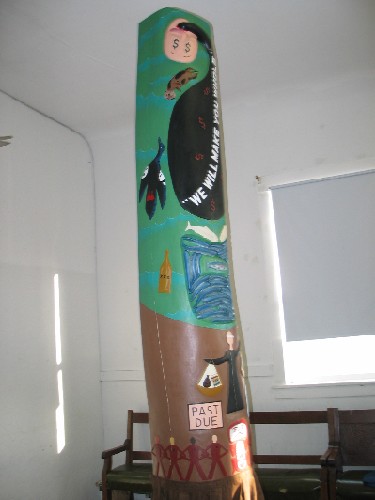
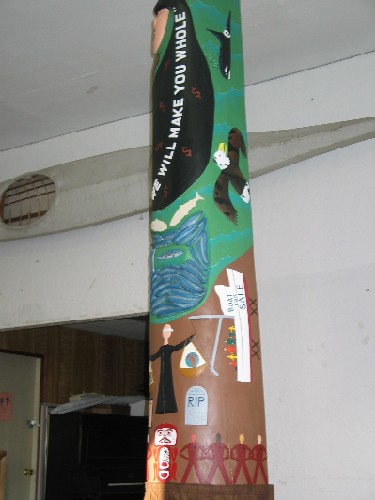
As a memorial to corporate greed and the labyrinths of the legal system, this ridicule pole is dedicated to Exxon, who has refused to meet its debt or recognize its obligation to the communities and ecosystems profoundly affected by the Exxon Valdez oil spill.
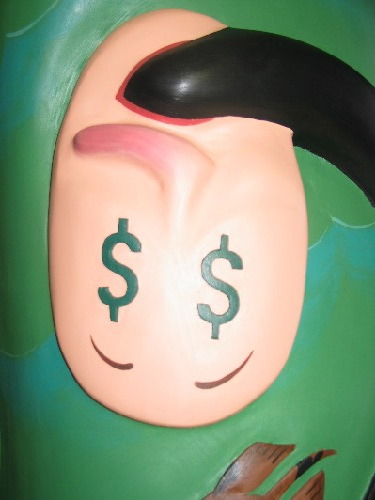 On
the top of this seven foot yellow cedar pole is the upside-down face of
Exxon’s now retired C.E.O., Lee Raymond. Four days after the oil
spill, an Exxon spokesperson flew to Cordova and assured the community
that we were lucky it was Exxon who spilled the oil. Exxon’s
ironic, much quoted words, “We will make you whole,” have
haunted Cordova these 18 years and are floating on the surface of the
oil.
On
the top of this seven foot yellow cedar pole is the upside-down face of
Exxon’s now retired C.E.O., Lee Raymond. Four days after the oil
spill, an Exxon spokesperson flew to Cordova and assured the community
that we were lucky it was Exxon who spilled the oil. Exxon’s
ironic, much quoted words, “We will make you whole,” have
haunted Cordova these 18 years and are floating on the surface of the
oil.
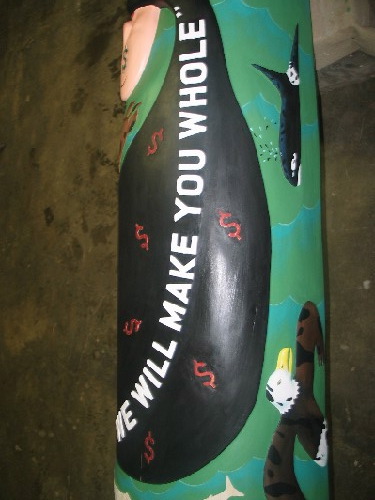 Lee
Raymond’s eyes are “$” signs, and his gaping mouth is
spilling oil, like the Exxon Valdez tanker that ran aground on Bligh
Reef in Prince William Sound, March 24, 1989. The oil that is breaching
out of Raymond’s mouth, turns into an oil slick littered with
“$” signs. One of the monikers for the oil spill is the
“Money Spill,” and those who worked on the clean-up were
referred to as the “spillionaires.” The Money Spill divided
communities and created ripples of social chaos that still affect
people nearly two decades later.
Lee
Raymond’s eyes are “$” signs, and his gaping mouth is
spilling oil, like the Exxon Valdez tanker that ran aground on Bligh
Reef in Prince William Sound, March 24, 1989. The oil that is breaching
out of Raymond’s mouth, turns into an oil slick littered with
“$” signs. One of the monikers for the oil spill is the
“Money Spill,” and those who worked on the clean-up were
referred to as the “spillionaires.” The Money Spill divided
communities and created ripples of social chaos that still affect
people nearly two decades later.
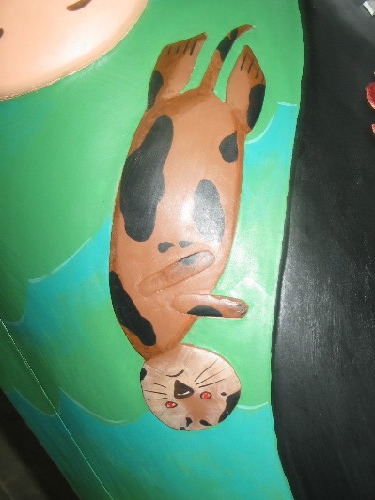
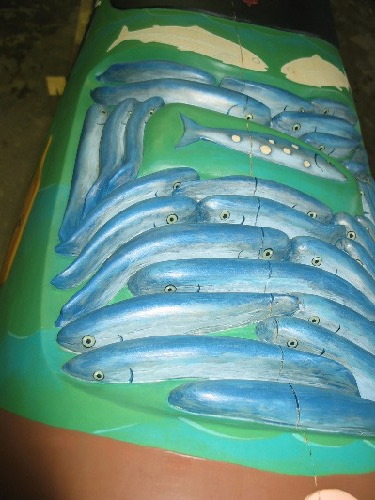 Floating lifeless around the spill are a dead sea otter, a dead sea duck, and a dead
eagle. An Orca whale is swimming around the spill, spouting water and
oil out of its blow hole. Below the oil spill are two skeletal herring
with a school of herring below. The bottom part of the school is tight
and dense, as healthy herring should look, but where the school is
closer to the spill, the herring get smaller and less dense. In the
middle of the school is a herring with lesions, representative of the
sick herring that returned to the Sound after the spill. The Prince
William Sound herring fishery crashed from a disease outbreak in 1993,
the year that young herring from 1989 should have become adults. The
population was further weakened by disease and the fishery has been
closed indefinitely since 1998. For Cordova’s people and economy
and the wildlife of the Sound, the loss has created lasting and
profound hardships.
Floating lifeless around the spill are a dead sea otter, a dead sea duck, and a dead
eagle. An Orca whale is swimming around the spill, spouting water and
oil out of its blow hole. Below the oil spill are two skeletal herring
with a school of herring below. The bottom part of the school is tight
and dense, as healthy herring should look, but where the school is
closer to the spill, the herring get smaller and less dense. In the
middle of the school is a herring with lesions, representative of the
sick herring that returned to the Sound after the spill. The Prince
William Sound herring fishery crashed from a disease outbreak in 1993,
the year that young herring from 1989 should have become adults. The
population was further weakened by disease and the fishery has been
closed indefinitely since 1998. For Cordova’s people and economy
and the wildlife of the Sound, the loss has created lasting and
profound hardships.
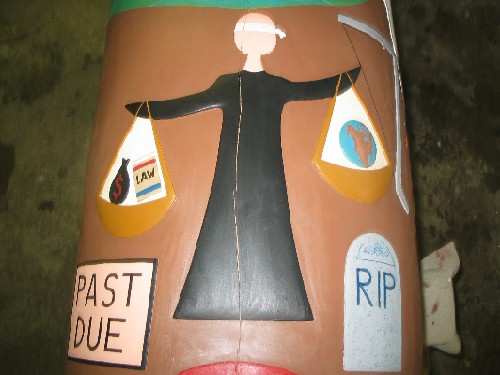 The
Lady of Justice with her scales is carved below the school of herring.
The Lady is blindfolded signifying the 18 years of legal entanglements
that have failed to bring an end to the oil spill litigation. On the
Exxon side of the scale is a bag of money and a law book: money and the
law appear to be on Exxon’s side. On the plaintiff’s side,
the scale holds the Earth. The Earth represents the environment,
animals, marine ecosystems, and the people who depend on them, in this
case the fishermen and Native people. Notably, in the eyes of the law,
the Exxon side weighs more.
The
Lady of Justice with her scales is carved below the school of herring.
The Lady is blindfolded signifying the 18 years of legal entanglements
that have failed to bring an end to the oil spill litigation. On the
Exxon side of the scale is a bag of money and a law book: money and the
law appear to be on Exxon’s side. On the plaintiff’s side,
the scale holds the Earth. The Earth represents the environment,
animals, marine ecosystems, and the people who depend on them, in this
case the fishermen and Native people. Notably, in the eyes of the law,
the Exxon side weighs more.
Under the plaintiff’s side of the scale is a tombstone in memory of at least 6,000 plaintiffs who have died since this court case began. In other words, 20 percent of the original plaintiffs have died without ever seeing compensation. In the first thirty days of carving this totem pole, five of my friends, who are also plaintiffs, died, adding to the oppressive list of the dead. Under Exxon’s side of the scale is a “Past Due” stamp, highlighting the agonizing length of this court case and the people’s demand for Exxon to pay its overdue bill.
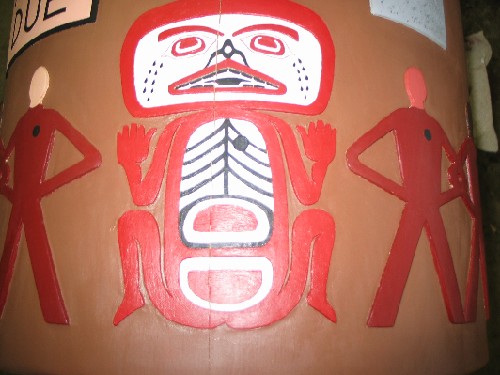 Under
the Lady of Justice is a Tlingit-style person crying tears of sadness
for the long years of lingering harm to the Sound, the wildlife, and
the people. This human-like figure is carved in x-ray, meaning that he
is very sick or dead. There is a hole in the heart of the Native,
signifying our interpretation of Exxon’s promise to “make
us [w]hole,” by taking a piece of our heart and soul. The Native
communities have suffered in complex ways from the spill. For example,
lingering oil buried on beaches continues to poison traditional
subsistence foods and harm wildlife that depends on this food. On both
sides of the crying Native are people standing together in unity and in
strength. This includes the cleanup workers who became sick from
working to clean up Exxon’s oil. Note that Exxon has taken away a
part of their “wholeness” as well.
Under
the Lady of Justice is a Tlingit-style person crying tears of sadness
for the long years of lingering harm to the Sound, the wildlife, and
the people. This human-like figure is carved in x-ray, meaning that he
is very sick or dead. There is a hole in the heart of the Native,
signifying our interpretation of Exxon’s promise to “make
us [w]hole,” by taking a piece of our heart and soul. The Native
communities have suffered in complex ways from the spill. For example,
lingering oil buried on beaches continues to poison traditional
subsistence foods and harm wildlife that depends on this food. On both
sides of the crying Native are people standing together in unity and in
strength. This includes the cleanup workers who became sick from
working to clean up Exxon’s oil. Note that Exxon has taken away a
part of their “wholeness” as well.
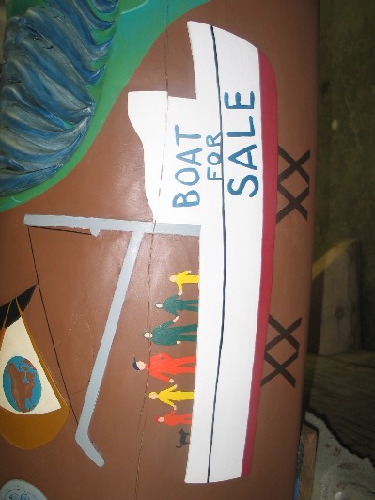 On
the lower right-hand side of the pole is a seine boat with a “For
Sale” sign on it and a family on the back deck. Of the fishing
industries, the Sound’s herring and salmon seine fisheries were
affected the most because fishermen were strapped by higher boat and
permit loans as well as other related costs that the fisheries could
not support after the spill. Many seine operations have gone bankrupt
since the spill and over half of the salmon seiners cannot afford to
fish their permits today. (Out of 267 of salmon seine boat permits,
only 103 are in operation.) Our once bustling harbor that
exploded with energy as fishermen prepared for a new season is now
greatly subdued.
On
the lower right-hand side of the pole is a seine boat with a “For
Sale” sign on it and a family on the back deck. Of the fishing
industries, the Sound’s herring and salmon seine fisheries were
affected the most because fishermen were strapped by higher boat and
permit loans as well as other related costs that the fisheries could
not support after the spill. Many seine operations have gone bankrupt
since the spill and over half of the salmon seiners cannot afford to
fish their permits today. (Out of 267 of salmon seine boat permits,
only 103 are in operation.) Our once bustling harbor that
exploded with energy as fishermen prepared for a new season is now
greatly subdued.
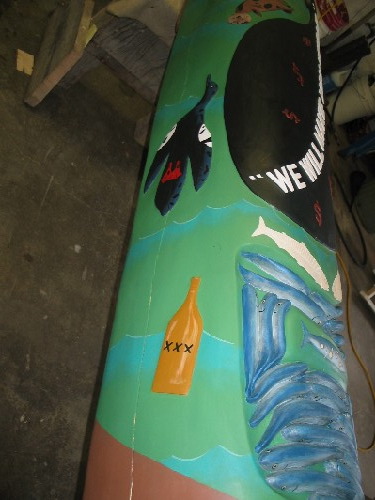 Finally,
there is the booze bottle on the Exxon side of the pole. Sadly, the
entire tragedy can be traced back to the misuse of alcohol by the
infamous Captain Hazelwood, a man known by his Exxon superiors to have
had a drinking problem. Eighteen years and 11 to 38 million gallons of
crude oil later, Exxon does not seem to be any closer to paying their
debt or recognizing their obligations. Exxon should be
ashamed.
Finally,
there is the booze bottle on the Exxon side of the pole. Sadly, the
entire tragedy can be traced back to the misuse of alcohol by the
infamous Captain Hazelwood, a man known by his Exxon superiors to have
had a drinking problem. Eighteen years and 11 to 38 million gallons of
crude oil later, Exxon does not seem to be any closer to paying their
debt or recognizing their obligations. Exxon should be
ashamed.
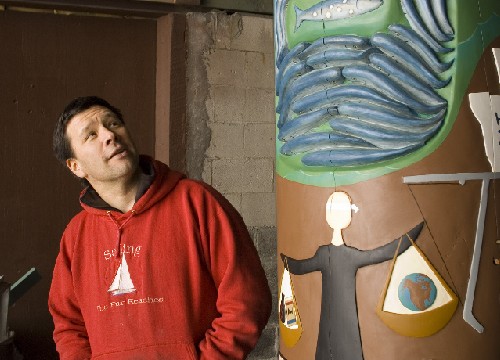 Mike
Webber is Alutiiq on his mother’s side from Prince William Sound
and Tlingit on his father’s side from Katalla and Cape Yakataga
on the North Gulf Coast. He has fished the waters of his ancestors
since he was six years old. In 1999, he broke his neck in a fishing
accident. During his long recovery, he read nonstop books on Native
carving and art. The books, and four master carvers, became his
teachers. Mike has been carving for seven years. He likes to carve
grease bowls, masks and paddles, and his goal is to replicate lost
artifacts and regalia. Mike lives with his family in Cordova.
Mike
Webber is Alutiiq on his mother’s side from Prince William Sound
and Tlingit on his father’s side from Katalla and Cape Yakataga
on the North Gulf Coast. He has fished the waters of his ancestors
since he was six years old. In 1999, he broke his neck in a fishing
accident. During his long recovery, he read nonstop books on Native
carving and art. The books, and four master carvers, became his
teachers. Mike has been carving for seven years. He likes to carve
grease bowls, masks and paddles, and his goal is to replicate lost
artifacts and regalia. Mike lives with his family in Cordova.